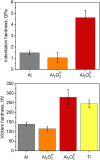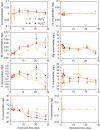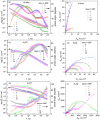Corrosion and Biocompatibility Studies of Bioceramic Alumina Coatings on Aluminum Alloy 6082
- PMID: 40249635
- PMCID: PMC12051176
- DOI: 10.1021/acsami.5c00532
Corrosion and Biocompatibility Studies of Bioceramic Alumina Coatings on Aluminum Alloy 6082
Abstract
Recent advances in ceramic materials, particularly porous alumina (Al2O3), have significantly enhanced the safety and efficacy of medical implants by improving biocompatibility and modulating cellular behavior for biomedical applications. Variations in the surface structure and chemical composition of porous Al2O3 promote different biological responses and coating stability, underscoring the need for further biological and corrosion research. Traditional methods for producing alumina ceramics from powder are expensive, time-consuming, and limited in their ability to create complex shapes and large structures due to the brittleness of alumina. This study evaluates the biocompatibility of bioceramic-coated aluminum (Al) alloy 6082 as a lightweight and cost-effective alternative for bone osteosynthesis plates. Al2O3 coatings were achieved through anodization using phosphoric and sulfuric acids. The untreated and anodized alloys were analyzed for chemical stability and biocompatibility and compared with medical-grade titanium alloy. All specimens exhibited excellent biocompatibility, demonstrating high adhesion and viability of the fibroblast cell line. Corrosion resistance and metal ion release were assessed in simulated body fluid, with all specimens effectively suppressing the release of Fe and toxic Al ions. The untreated Al alloy exhibited a higher release of Mn ions than the coated specimens. Notably, the bioceramic coating obtained in sulfuric acid demonstrated 3 orders of magnitude higher corrosion resistance, indicating its potential suitability for biomedical applications. By addressing the limitations of traditional alumina ceramics, our approach enables the fabrication of products in diverse sizes and shapes, offering a practical solution for creating customized biomedical implants.
Keywords: cell adhesion; osteosynthesis plates; porous Al2O3; simulated body fluid; viability.
Conflict of interest statement
The authors declare no competing financial interest.
Figures











Similar articles
-
Fabrication of TiO2-SiO2 bioceramic coatings on Ti alloy and its synergetic effect on biocompatibility and corrosion resistance.J Mech Behav Biomed Mater. 2015 Jun;46:205-21. doi: 10.1016/j.jmbbm.2015.02.006. Epub 2015 Mar 3. J Mech Behav Biomed Mater. 2015. PMID: 25817608
-
Integration of 3% Silver-Doped Hydroxyapatite Coated on Alumina Using Radio Frequency Magnetron Sputtering for Superior Bioactivity, Mechanical and Electrical Properties, and Wear Resistance.ACS Biomater Sci Eng. 2025 May 12;11(5):2622-2638. doi: 10.1021/acsbiomaterials.4c02471. Epub 2025 Apr 29. ACS Biomater Sci Eng. 2025. PMID: 40302235
-
The role of pH on structure, corrosion behavior and biocompatibility of MgFe layered double hydroxide coating on Mg-Nd-Zn-Zr alloy.Sci Rep. 2025 Apr 28;15(1):14842. doi: 10.1038/s41598-025-98555-2. Sci Rep. 2025. PMID: 40295569 Free PMC article.
-
Calcium phosphate-based coatings on titanium and its alloys.J Biomed Mater Res B Appl Biomater. 2008 Apr;85(1):279-99. doi: 10.1002/jbm.b.30932. J Biomed Mater Res B Appl Biomater. 2008. PMID: 17853421 Review.
-
Tailoring the biological response of zirconium implants using zirconia bioceramic coatings: A systematic review.J Trace Elem Med Biol. 2021 Jul;66:126756. doi: 10.1016/j.jtemb.2021.126756. Epub 2021 Apr 2. J Trace Elem Med Biol. 2021. PMID: 33831798
References
-
- Adel-Khattab D.; Giacomini F.; Gildenhaar R.; Berger G.; Gomes C.; Linow U.; Hardt M.; Peleska B.; Günster J.; Stiller M.; Houshmand A.; Ghaffar K. A.; Gamal A.; El-Mofty M.; Knabe C. Development of a Synthetic Tissue Engineered Three-Dimensional Printed Bioceramic-Based Bone Graft with Homogenously Distributed Osteoblasts and Mineralizing Bone Matrix in Vitro. J. Tissue Eng. Regener. Med. 2018, 12 (1), 44–58. 10.1002/term.2362. - DOI - PubMed
-
- Kim S. W.; Khalil K. A.-R. High-Frequency Induction Heat Sintering of Mechanically Alloyed Alumina–Yttria-Stabilized Zirconia Nano-Bioceramics. J. Am. Ceram. Soc. 2006, 89 (4), 1280–1285. 10.1111/j.1551-2916.2005.00902.x. - DOI
MeSH terms
Substances
LinkOut - more resources
Full Text Sources

